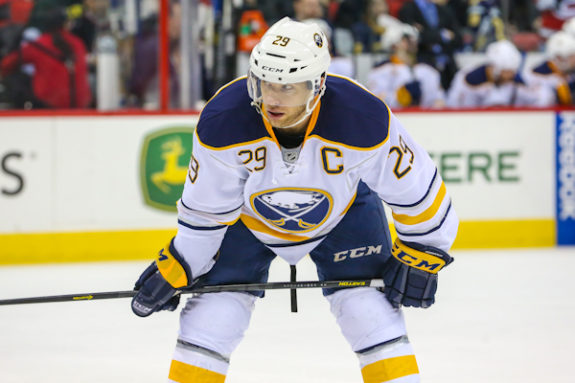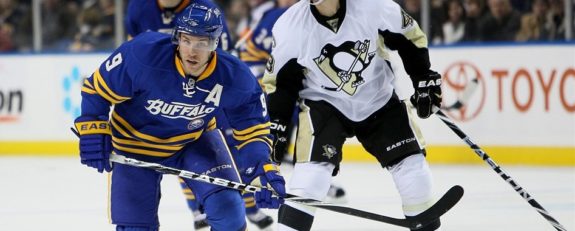The good old “Buffaslug” was maybe one of, if not the worst rebranding in NHL history. The Buffalo Sabres ushered in their new logo in 2006-07 after a season in which they fell just one game short of making the Stanley Cup Final. In the first season of the logo change, the Sabres once again made the Eastern Conference Final but fell to the Ottawa Senators.
During that offseason, Daniel Briere and Chris Drury left in free agency and signed new deals elsewhere, which meant a new top line needed to step up for the 2007-08 season. Enter the line combination of Thomas Vanek, Derek Roy and Jason Pominville. This line came to define the “slug” jerseys despite the Sabres only making the playoffs in them twice. Let’s take a look back at the production of the top players of the “Buffaslug” jersey era from 2006-2010.
Jason Pominville, Right Wing (105 Goals, 171 Assists, 276 Points)
Pominville made his debut in the 2003-04 season and didn’t get consistent NHL playing time until the 2005-06 season after getting off to a hot start in the American Hockey League (AHL). He took off in his second full season in the league, and first in the new uniforms, playing in all 82 games and putting up 68 points on a career-high 34 goals and 34 assists.
Pominville carried this success into his second playoffs and put up 10 points in 16 games before the team was eliminated by the Senators. Following this defeat and the departure of Drury and Briere, he put up a career-high in points with 80 and assists with 53. He also was a finalist for the Lady Byng Trophy with only 20 penalty minutes on the year.

Despite Pominville’s career year in 2007-08, the Sabres missed the playoffs by just two points. The following seasons of 2008-09 and 2009-10 were nearly identical stats-wise, as the winger put up 66 and 62 points respectively; the only difference being the Sabres qualified for the playoffs the second year.
Pominville again showed up in the 2010 Playoffs against the Boston Bruins as he tallied four points on two goals and two assists in the six-game loss to close out the “Buffaslug” era. He remained with the team for another two and a half seasons before being dealt to the Minnesota Wild at the 2013 Trade Deadline. After five seasons in Minnesota, he wrapped up his career back in Buffalo playing his final two seasons with the Sabres.
Derek Roy, Center (107 Goals, 176 Assists, 283 Points)
Roy is one of the more underrated players in franchise history. Would you have guessed he had the most points for the team from 2006-2010? The center joined the Sabres in 2003-04 and played in 49 games in a limited role. After the lockout, he played on the 2005-06 team that fell a game short of the Final and put up 48 points in the regular season and 15 points in 18 playoff games.
Once the “Buffaslug” was revealed, Roy’s game took a huge jump. In the 2006-07 season, he scored 21 goals and tallied 42 assists playing a third-line center role behind Briere and Drury. In the year following their departures, Roy, like Pominville, put up career numbers across the board and led the 2007-08 Sabres in scoring with 32 goals and 49 assists for 81 points in 78 games.

In the following two seasons, Roy continued putting up respectable first-line numbers with 70 and 69-point seasons respectively. He put up three consecutive 25-goal seasons after his career-high campaign in 2007-08 and although the Sabres missed the playoffs in his best seasons, he was still a key contributor on those late 2000s teams.
Related: Buffalo Sabres Jersey History
After the Sabres changed back to their old logo in 2010-11, Roy was on a point-per-game pace with 35 points in 35 games before a quad tear ended his season. Unfortunately, he was never the same player after that putting up only 44 points in 80 games in the season after returning from injury and in that offseason, he was dealt to the Dallas Stars for Steve Ott and Adam Pardy. He never returned to his point-per-game pace and was out of the league by 2014-15.
Thomas Vanek, Left Wing (147 Goals, 118 Assists, 265 Points)
The most remembered player by both Sabres fans and fans around the league, Thomas Vanek made his NHL debut post-lockout and put up 25 goals in his rookie year, but struggled in the playoffs while the team still had success. The following 2006-07 season, he set career highs across the board including 43 goals to lead the Sabres and was tied for fifth in the league. He also led the NHL in plus/minus with a whopping plus-47 rating.
The Austrian also showed up in the playoffs recording six goals and four assists across 16 playoff games in an Eastern Conference Final exit. In the 2007-08 season, the Sabres needed him to become the face of the franchise and unfortunately, he never took that next step after his 84-point campaign recording 64 points in both 2007-08 and 2008-09.

Vanek’s goal-scoring touch was still there as he posted 36 and 40 goals in those seasons respectively and the lowered assist numbers can be attributed to his larger role of being the go-to guy for scoring. As mentioned, the Sabres missed the playoffs in those two seasons and didn’t make it back until 2009-10. That season was the worst of Vanek’s career to that point.
The winger scored only 28 goals and 53 points, and while he was still the Sabres’ top goal scorer, this downward trend in production over his last three seasons was a concern. Despite this, they actually won the division with 101 points securing the third seed in the Eastern Conference in the process. However, they were bounced by the Bruins in six games. He was off to a hot start in the series with three points in three games (two of them goals) before he was injured on a slash by Johnny Boychuk and missed the rest of the series.
Vanek bounced back the following season with a 73-point campaign and remained with the Sabres until October 2013 when he was dealt to the New York Islanders for Matt Moulson and a first and second-round pick. He played for seven different teams after Buffalo, including the New York Islanders, and officially retired in February 2020.
The era of Sabres hockey between 2006-2010 was one with highs of making the Eastern Conference Final and lows of just missing out on them or disappointing first-round exits. They had a talented group of forwards even in the late-2000s and one of the best goaltenders in the league in Ryan Miller. And while the teams and players from the mid-2000s “Goat-Head” jersey era get a lot more of the love, the top players of the “Buffaslug” era weren’t slouches by any means and it’s a shame they couldn’t put it all together and win a Stanley Cup.
